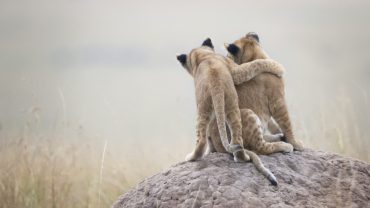The Discovery Channel was the visionary brainchild of John Samuel Hendricks, a University of Alabama history graduate with a passion for making educational and documentary programming accessible to the masses. In 1982, Hendricks founded Cable Educational Network, Inc. in Maryland, with the idea of creating a television network that would satisfy the curiosity of what he called lifelong learners and bring the wonders of science, history, and nature into people’s homes.
In this article, we’ll look at the humble beginnings of the Discovery Channel, how the channel grew in the USA and beyond, the astonishing popularity of Shark Week, some of the channel’s most popular shows, and its legacy as one of the world’s premier broadcasters.
The Early Years: A Window to the World

Discovery's early programming focussed on science, history, culture and wildlife (Credit: dima_zel via Getty Images)
With $5 million in startup capital from investors which included the BBC, Allen & Company, and Venture America, Hendricks launched the Discovery Channel in the USA on June 17, 1985. At the time, the channel was available in just 156,000 households and broadcast for twelve hours a day, from 3PM to 3AM, a humble start for what would become a global media giant.
From its inception, the Discovery Channel set itself apart by offering programming that was both educational and adventurous. About seventy-five percent of its early content had never been broadcast on American television before. The schedule was packed with cultural and wildlife documentaries, science and history specials, and it even broadcast programming from the Soviet Union, offering viewers a rare glimpse behind the Iron Curtain during the Cold War.
The channel also experimented with interactive features, such as teletext services that provided news, trivia, and even prices of stocks and shares, all delivered via the television screen – an early nod to the interactive experiences that would later define digital media.
Growth, Innovation, and Global Expansion

Dave Kindig & Kevin Schiele from Bitchin' Rides - the personalities made the programmes.
Launching a TV channel is expensive and fraught with risk, and like many start-ups, the Discovery Channel was not without early teething problems, but with the determination and passion of Hendricks, and the support of fellow cable operators, Discovery not only survived, but thrived. By the summer of 1986, the channel had over seven million subscribers.
The 1990s marked a period of rapid expansion. Discovery Channel Europe launched in 1989, followed by a wave of international growth into Asia, Africa, Latin America, and the Middle East. The company also diversified, acquiring The Learning Channel (TLC) in 1991 and launching new networks such as Animal Planet, Discovery Kids, and Discovery Health Channel through the late 1990s.
In the early 2000s, Discovery looked to attract a broader audience with the addition of reality-type shows focused on cars and bikes, jobs, and speculative investigation series. These shows helped to attract a wider audience, blending technical know-how, the spirit of competition, and compelling personalities to create a new and exciting era of factual entertainment programming.
Programming: From Documentaries to Icons

Paul Teutul Sr & Paul Teutul Jr from American Chopper
The Discovery Channel’s reputation was built on high-quality documentaries, but as the channel evolved it also became known for its bold, often adrenaline-fuelled programming. Over time, certain themes – particularly sharks and military history – became closely associated with the channel. The fascination with sharks reached its peak with the launch of Shark Week in 1988, a programming event that has become a summer television tradition, but we’ll get to that in a minute.
Discovery Channel has produced and aired a vast array of original programming, many of which have become cultural landmarks. Some of the channel’s most popular and enduring shows include:
- American Chopper: Paul Teutul and his son Paul Jr. push the envelope of custom motorcycle design and production, as well as putting their relationship to the ultimate test.
- MythBusters: A science entertainment series that tested the validity of urban legends and myths, beloved for its hands-on experiments and charismatic hosts.
- Deadliest Catch: Chronicling the perilous world of Alaskan crab fishermen, this reality series has captivated audiences with its raw depiction of danger and teamwork.
- Gold Rush: Following modern-day gold miners, this series has become a staple for fans of adventure and entrepreneurship.
- How It’s Made: A behind-the-scenes look at how everyday items are manufactured, satisfying the curiosity of viewers of all ages.
- Dirty Jobs: Hosted by Mike Rowe, this show highlighted the unsung heroes who perform America’s toughest and messiest jobs.
- Naked and Afraid: A survival reality series that pushes contestants to their limits in remote wilderness settings.
Today, Discovery’s lineup continues to evolve, with hits including Expedition Unknown, Moonshiners, Homestead Rescue, Gold Divers, Marooned with Ed Stafford and Alaskan Bush People keeping audiences engaged and entertained.
The Phenomenon of Shark Week

Shark Week is a global phenomenon.
One of the most often-told stories about the genesis of Shark Week is that a group of Discovery executives were in a bar and one of them said something along the lines of ‘You know what would be awesome? Shark Week!’ However former executive Eileen O’Neill suggests it wasn’t as exciting.
In her version of the story, Hendricks and a scheduler were brainstorming ideas to boost summer viewing figures. They stumbled on the premise that programmes about sharks rated well and decided to broadcast a series of shows about sharks.
Whichever story is true, Shark Week launched in July 1988 with a ten-part show called Caged in Fear. The initial focus was on dispelling myths, promoting conservation, and correcting misconceptions about sharks, which were often misunderstood and unfairly maligned in popular culture.
The first Shark Week was a resounding success, and it very quickly established itself as a summer tradition. Over the years, Shark Week has evolved into a global phenomenon, attracting millions of viewers annually and expanding its reach to over seventy countries. In fact it’s the longest-running cable television programming event in history.
Its enduring popularity is fuelled by a mix of thrilling shark encounters, celebrity hosts, and cutting-edge scientific exploration. Shark Week has not only entertained but also inspired greater appreciation for these fascinating creatures. If you want to know what all the fuss is about, we’ve got you covered, here on Discovery+!
Shark Week Hosts
Being asked to host Shark Week on the Discovery Channel is similar to being asked to host the Oscars! The first guest host in 1994 was none other than Peter Benchley, the author of Jaws, and co-writer of the movie screenplay that went on to become the original summer blockbuster.
There was a hiatus until 2000, when British wildlife TV presenter, naturalist and conservationist Nigel Marven took the helm, and then in 2004, Paul Teutul Sr & Jr and the cast of Orange County Choppers took up hosting duties. In 2005 Mythbusters hosts Adam Savage and Jamie Hyneman took charge, and in the years that followed, there was a real mixed bag of celebrities fronting the most famous week in TV.
Comedian and actor Andy Samberg (of Brooklyn Nine-Nine fame) hosted in 2011, and the following year, YouTuber Philip DeFranco was in charge. More recently, hosts have included basketball star Shaquille O’Neal, former WWE wrestler-turned-A-list superstar Dwayne ‘The Rock’ Johnson, actor Jason Momoa, and in 2024, they went back to the wrestling world for legend John Cena. He’s also due to host in 2025.
Discovery By The Numbers: Global Reach & Impact

Animal Planet tells stories of some of the world's most astonishing creatures (Credit: mraxpa via Getty Images)
The Discovery Channel’s growth over forty years is nothing short of extraordinary.
- Global Reach: Discovery Channel is now available in over 220 countries and territories, reaching hundreds of millions of viewers every month.
- Languages: Content is broadcast in nearly fifty languages, including Hindi, Tamil, Bengali, Hungarian, Estonian and Serbian, making Discovery’s programming accessible to a truly global audience.
- Brands and Channels: The Discovery family includes iconic brands like Animal Planet, TLC, Science Channel, and Discovery Kids, as well as digital streaming through discovery+. In the UK, the suite of channels under the WBD – Warner Bros. Discovery – umbrella includes Quest, DMAX, Really, TNT Sports, HGTV and Food Network.
- Audience: Discovery consistently ranks among the most-watched factual networks worldwide, with a loyal fan base that spans generations and continents.
A Legacy of Curiosity and Wonder

Forty years of wonder, and here's to forty more! (Credit: Georgette Douwma via Getty Images)
Forty years on, Discovery Channel remains true to John Hendricks’ founding vision. To inspire curiosity, foster learning, and bring the wonders of the world into people’s homes. From the depths of the ocean to the farthest reaches of space, Discovery continues to push the boundaries of factual entertainment, always with a sense of adventure, wonder, and fun.












